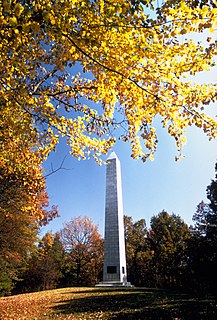 W
WUSS Clamagore (SS-343) is a Balao-class submarine, presently a museum ship at the Patriot's Point Naval & Maritime Museum outside Charleston, South Carolina. Built in 1945 for the United States Navy, she was still in training when World War II ended. She was named for the clamagore. A National Historic Landmark, she is the only known surviving example of a GUPPY type submarine.
 W
WFort Moultrie is a series of fortifications on Sullivan's Island, South Carolina, built to protect the city of Charleston, South Carolina. The first fort, formerly named Fort Sullivan, built of palmetto logs, inspired the flag and nickname of South Carolina, as "The Palmetto State". The fort was renamed for the U.S. patriot commander in the Battle of Sullivan's Island, General William Moultrie. During British occupation, in 1780–1782, the fort was known as Fort Arbuthnot.
 W
WKings Mountain National Military Park is a National Military Park near Blacksburg, South Carolina, along the North Carolina/South Carolina border. The park commemorates the Battle of Kings Mountain, a pivotal and significant victory by American Patriots over American Loyalists during the Southern Campaign of the Revolutionary War. It was listed on the National Register of Historic Places in 1996. Thomas Jefferson considered the battle "The turn of the tide of success."
 W
WUSS Laffey (DD-724) is an Allen M. Sumner-class destroyer, which was constructed during World War II, laid down and launched in 1943, and commissioned in February 1944. The ship earned the nickname "The Ship That Would Not Die" for her exploits during the D-Day invasion and the battle of Okinawa when she successfully withstood a determined assault by conventional bombers and the most unrelenting kamikaze air attacks in history. Today, Laffey is a U.S. National Historic Landmark and is preserved as a museum ship at Patriots Point, outside Charleston, South Carolina.
 W
WThe Parris Island Museum is located at Building 111, Panama Street, Marine Corps Recruit Depot Parris Island in Beaufort, South Carolina, United States. The museum consists of a 10,000-square-foot (930 m2) facility and includes exhibits of the history of the United States Marine Corps as well as the history of the Port Royal region. Exhibits cover the span of time and occupancy of the island, from Native American civilization and French and Spanish colonies to modern day. Other exhibits display artifacts from the early 19th century to the present day.
 W
WPatriots Point Naval & Maritime Museum is located in Mount Pleasant, South Carolina, at the mouth of the Cooper River on the Charleston Harbor, across from Charleston.
 W
WThe Powder Magazine is a gunpowder magazine and museum at 79 Cumberland Street in Charleston, South Carolina, USA. Completed in 1713, it is the oldest surviving public building in the former Province of Carolina. It was used as a gunpowder store through the American Revolutionary War, and later saw other uses. The Powder Magazine was declared a National Historic Landmark in 1989. It has been operated as a museum by the National Society of the Colonial Dames of America since the early 1900s. It was designated a National Historic Landmark in 1972.
 W
WThe Chaplain Corps of the United States Army consists of ordained clergy of multiple faiths who are commissioned Army officers serving as military chaplains as well as enlisted soldiers who serve as assistants. Their purpose is to offer religious church services, counseling, and moral support to the armed forces, whether in peacetime or at war.
 W
WUSS Yorktown (CV/CVA/CVS-10) is one of 24 Essex-class aircraft carriers built during World War II for the United States Navy. She was named after the Battle of Yorktown of the American Revolutionary War, and is the fourth U.S. Navy ship to bear the name. Initially to have been named Bonhomme Richard, she was renamed Yorktown while still under construction to commemorate the loss of USS Yorktown (CV-5) during the Battle of Midway in June 1942. Yorktown was commissioned in April 1943, and participated in several campaigns in the Pacific Theater of Operations, earning 11 battle stars and the Presidential Unit Citation.